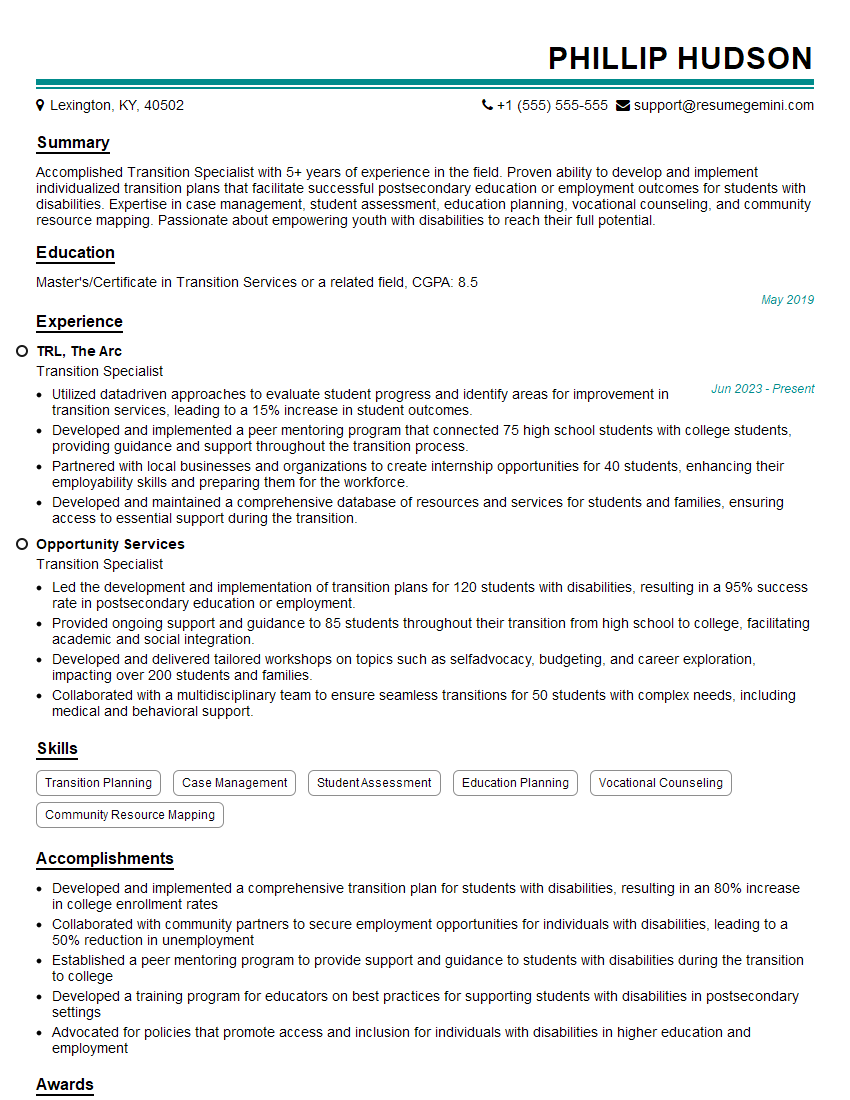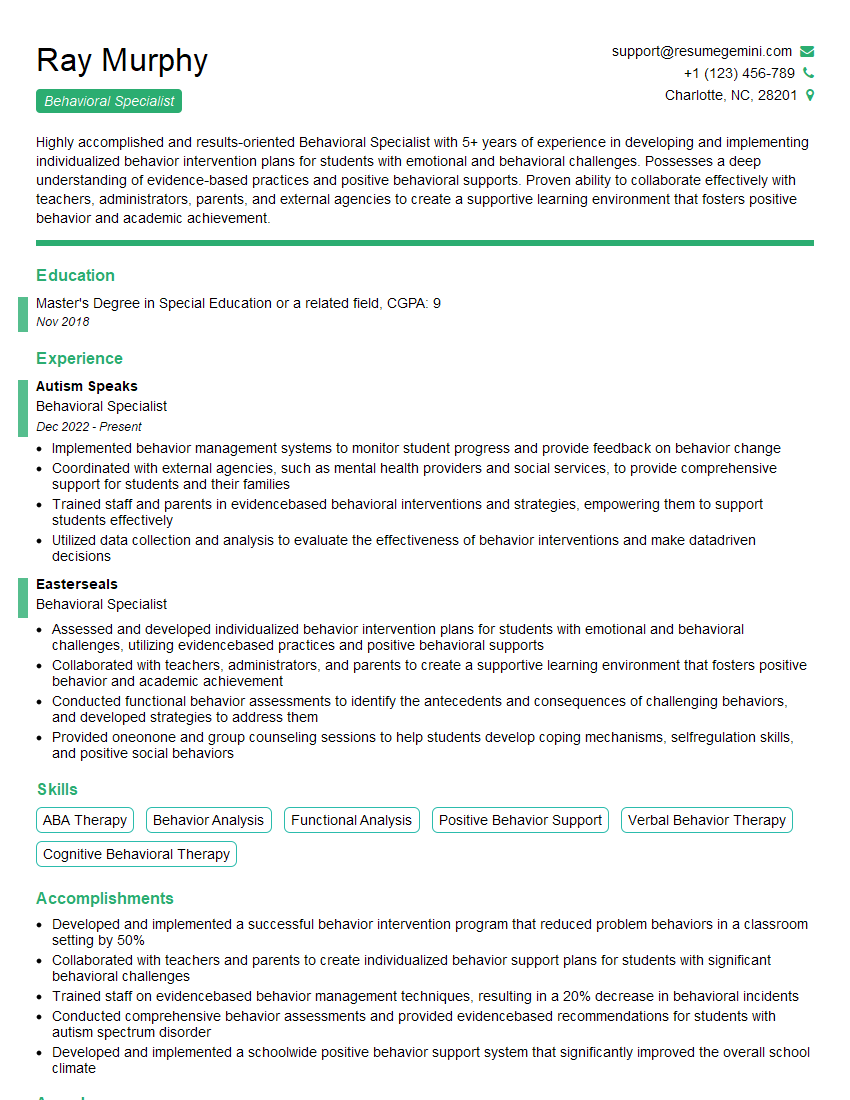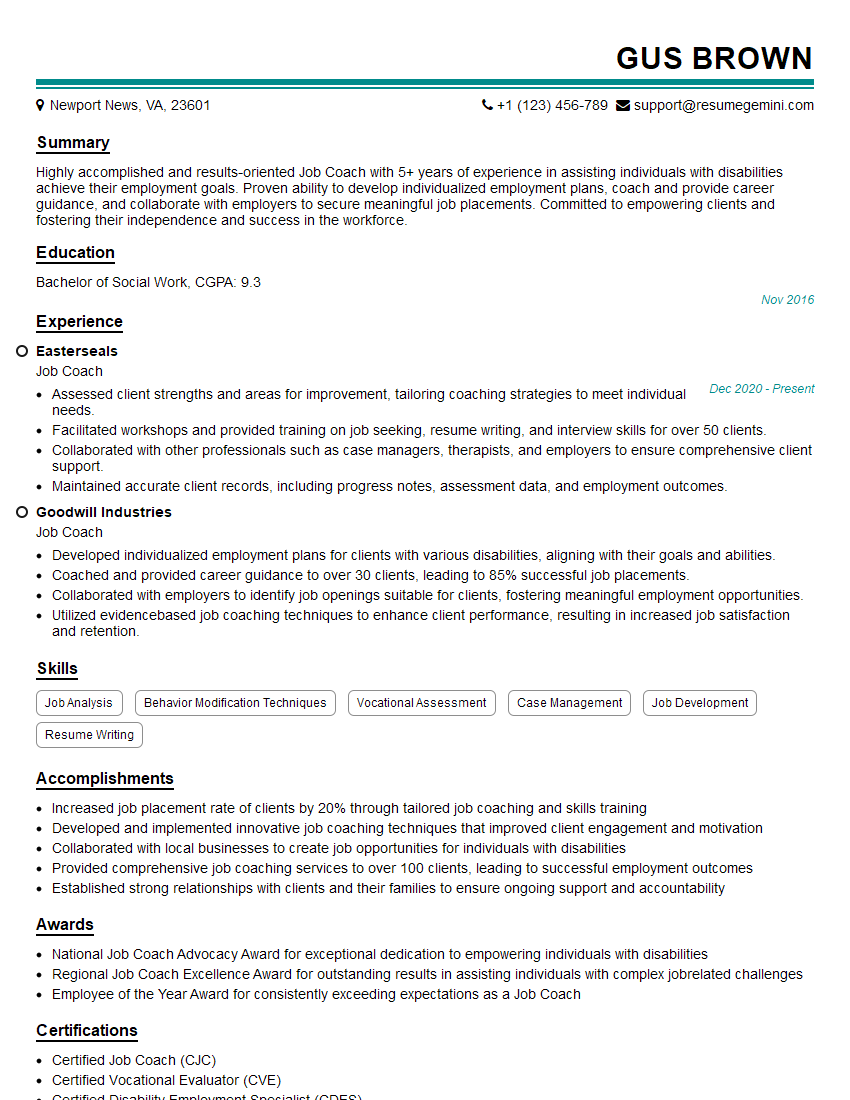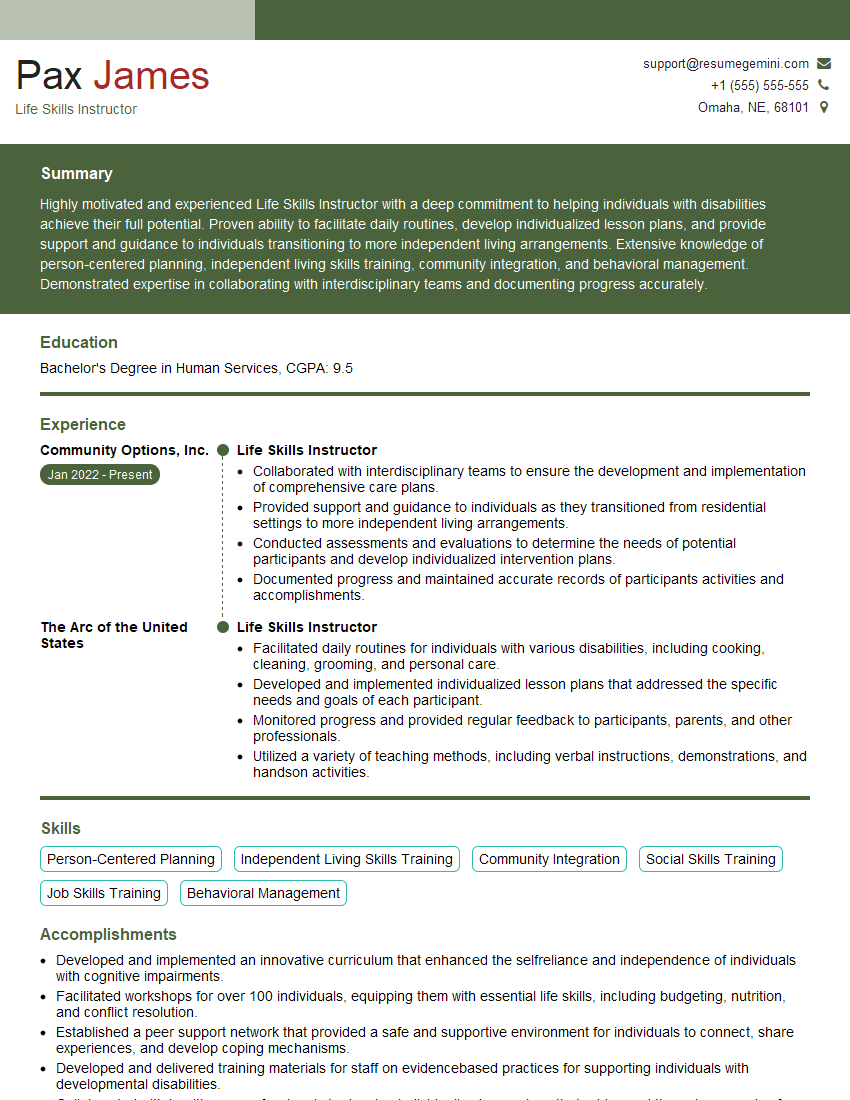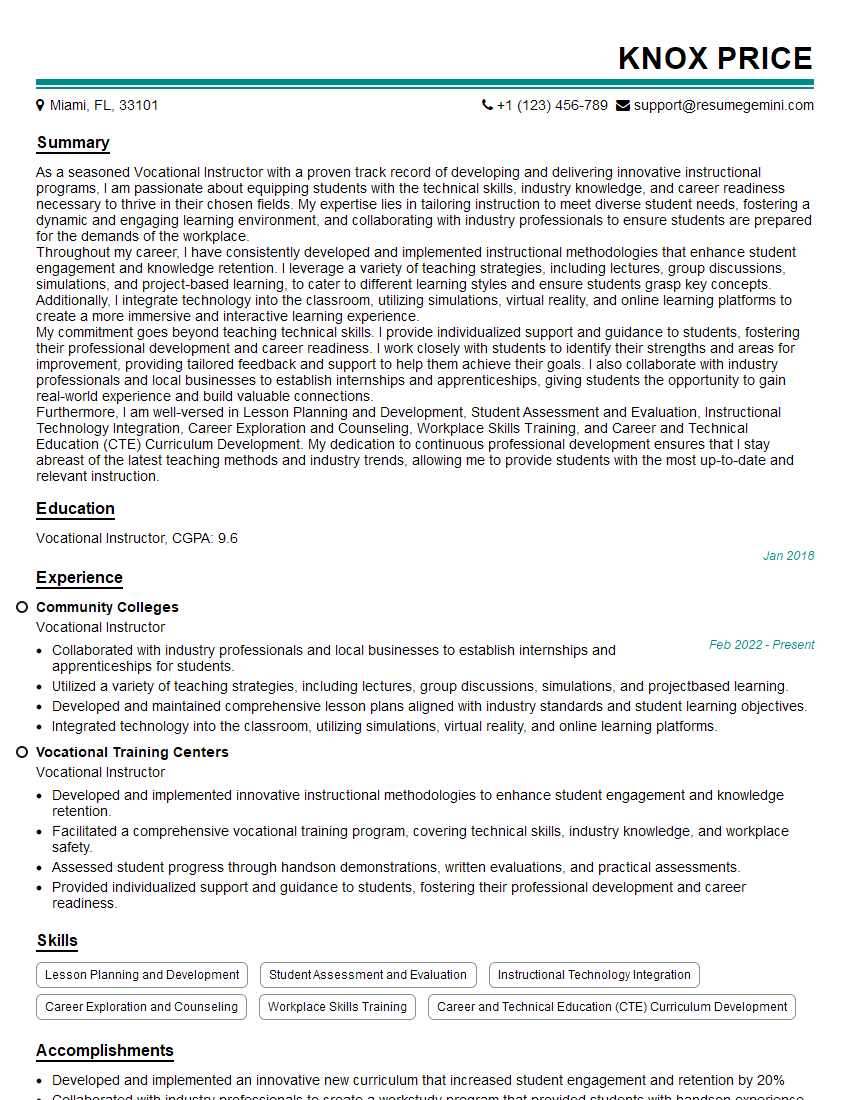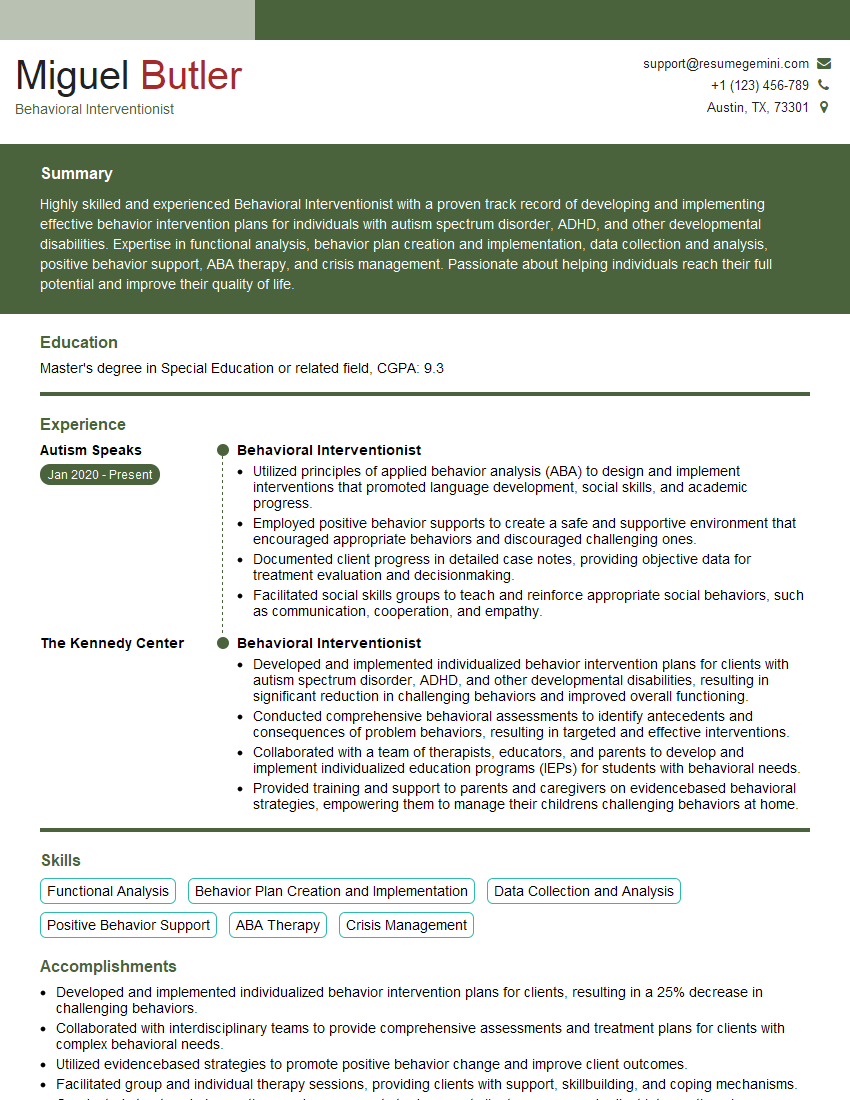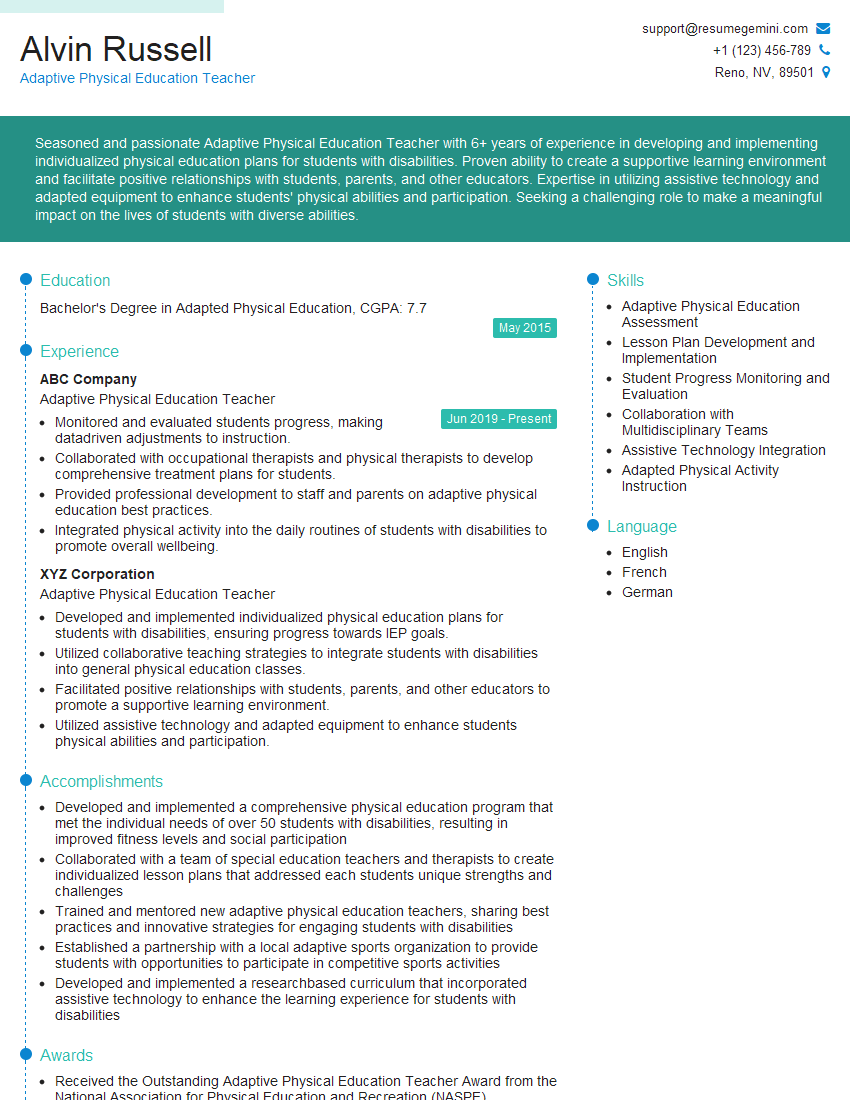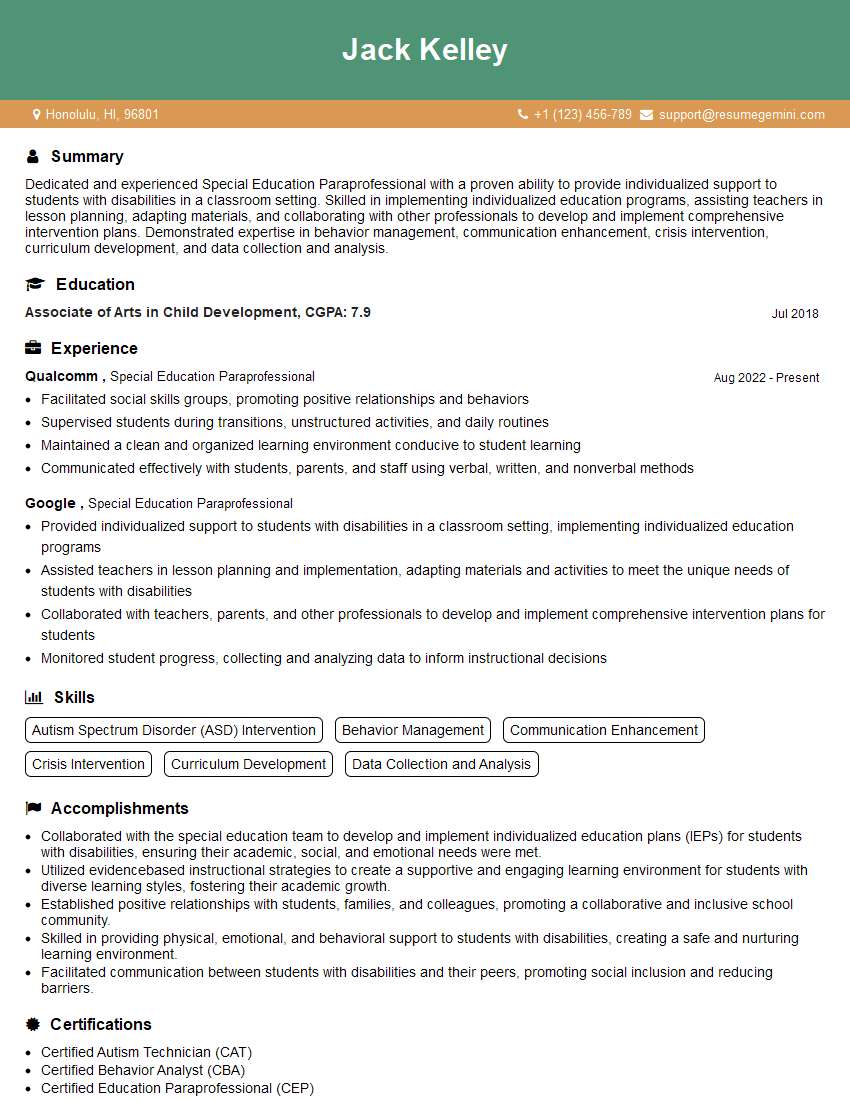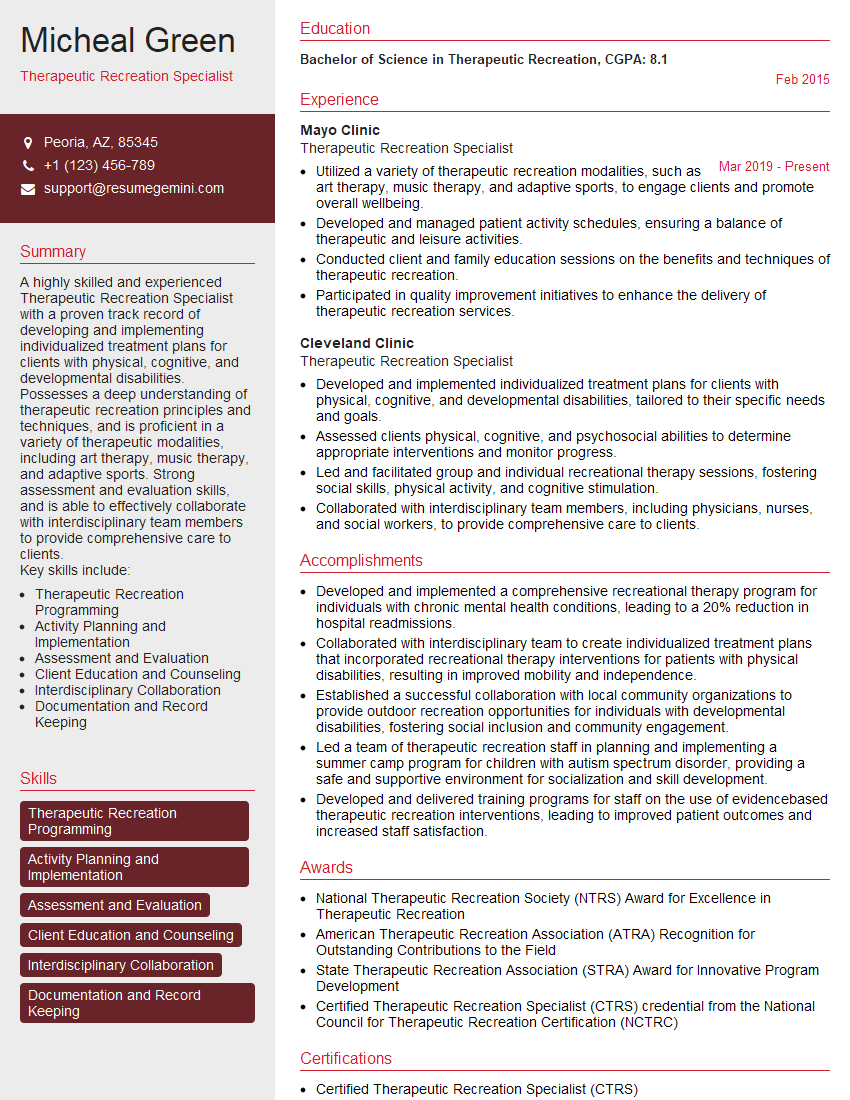Unlock your full potential by mastering the most common Life Skills Instruction for Students with Mental Handicaps interview questions. This blog offers a deep dive into the critical topics, ensuring you’re not only prepared to answer but to excel. With these insights, you’ll approach your interview with clarity and confidence.
Questions Asked in Life Skills Instruction for Students with Mental Handicaps Interview
Q 1. Describe your experience adapting curriculum to meet the diverse needs of students with mental handicaps.
Adapting curriculum for students with mental handicaps requires a deep understanding of individual needs and learning styles. It’s not a one-size-fits-all approach. I start by thoroughly reviewing each student’s Individualized Education Program (IEP) to understand their strengths, weaknesses, and specific goals. Then, I analyze the existing curriculum, identifying areas that need modification. This might involve breaking down complex tasks into smaller, more manageable steps, using visual aids and hands-on activities, incorporating technology, or adjusting the pace of instruction. For example, if teaching money management, instead of abstract concepts, I might use real coins and bills and role-play scenarios like buying groceries at a pretend store. For a student struggling with reading comprehension, I might use graphic organizers or audiobooks to support their understanding.
Furthermore, I regularly assess student progress and make adjustments as needed. Flexibility is key. What works for one student might not work for another. Continuous monitoring and adaptation are crucial for ensuring that all students are making progress towards their individual goals.
Q 2. Explain your understanding of Individualized Education Programs (IEPs) and their role in life skills instruction.
Individualized Education Programs (IEPs) are legally mandated documents that outline the specific educational needs and goals of students with disabilities. In the context of life skills instruction, the IEP is the cornerstone of the entire process. It details the student’s present levels of performance (PLP) in various life skills areas, such as personal care, communication, social skills, and vocational skills. It also specifies measurable goals, the services the student will receive (e.g., one-on-one support, assistive technology), and how their progress will be monitored. The IEP team—which includes parents, teachers, specialists, and the student (when appropriate)—works collaboratively to develop and implement the IEP. Without a well-defined IEP, providing effective life skills instruction becomes significantly more challenging.
For example, an IEP might specify that a student needs to learn to brush their teeth independently. The IEP would outline specific steps to achieve this, such as visual schedules, verbal prompts, and positive reinforcement. Regular progress monitoring ensures the IEP goals are being met and adjustments are made as needed.
Q 3. How do you assess a student’s current life skills level and identify areas for improvement?
Assessing a student’s current life skills level involves a multi-faceted approach. I use a combination of methods to obtain a comprehensive understanding. This includes:
- Observations: Observing the student in various settings (classroom, community, home) provides valuable insights into their abilities and challenges.
- Interviews: Talking to the student, parents, and other professionals involved in their care provides crucial information.
- Standardized Assessments: Using standardized tests, such as adaptive behavior scales, can help objectively measure specific life skills.
- Curriculum-Based Assessments: Regularly assessing the student’s performance on specific curriculum tasks helps track progress and identify areas needing more support.
- Functional Behavioral Assessments (FBAs): In cases of challenging behaviors, FBAs help identify the function of those behaviors and inform strategies for intervention.
By combining these methods, I create a detailed picture of the student’s strengths and weaknesses, allowing for targeted instruction focusing on areas needing improvement.
Q 4. What strategies do you employ to teach functional living skills, such as personal care and hygiene?
Teaching functional living skills like personal care and hygiene requires a structured, hands-on approach. I use a variety of strategies, including:
- Task Analysis: Breaking down complex tasks (e.g., showering) into smaller, sequential steps.
- Visual Supports: Using visual schedules, picture cards, or videos to guide students through each step.
- Modeling and Prompting: Demonstrating the correct procedure and providing verbal or physical prompts as needed.
- Positive Reinforcement: Rewarding progress and success with praise, tokens, or other reinforcers.
- Practice and Repetition: Providing ample opportunities for practice in a supportive environment.
- Role-Playing and Simulation: Creating realistic scenarios (e.g., a mock bathroom) to practice skills in a safe environment.
For example, when teaching toothbrushing, I might use a visual schedule with pictures showing each step: wet toothbrush, apply toothpaste, brush each section of teeth, rinse, etc. I would then model the procedure, providing verbal prompts and physical assistance as needed, gradually fading support as the student gains independence. Throughout the process, I provide consistent positive reinforcement.
Q 5. How do you adapt instruction for students with various learning styles and communication challenges?
Adapting instruction for diverse learning styles and communication challenges is crucial. I employ a variety of strategies to address individual needs:
- Multi-Sensory Approach: Incorporating visual, auditory, and kinesthetic elements into lessons to cater to various learning preferences.
- Assistive Technology: Utilizing technology such as augmentative and alternative communication (AAC) devices, speech-to-text software, or visual organizers.
- Differentiated Instruction: Providing varied materials and activities to meet individual learning needs. This might include offering different levels of support, using different formats (e.g., videos, worksheets, hands-on activities), and adjusting the pace of instruction.
- Adaptive Teaching Strategies: Using strategies such as pre-teaching key vocabulary, providing visual cues, and breaking down tasks into smaller, manageable chunks.
For a student with limited verbal communication, I might use picture exchange communication systems (PECS) to support their participation in activities. For a student who learns best through hands-on activities, I might incorporate more tactile elements into lessons. The key is to be flexible and creative in finding ways to reach each student effectively.
Q 6. Describe your experience working with students exhibiting challenging behaviors. What de-escalation techniques do you use?
Working with students who exhibit challenging behaviors requires patience, understanding, and a proactive approach. My strategies focus on identifying the underlying causes of the behavior and developing positive interventions. I begin by conducting a Functional Behavior Assessment (FBA) to determine the function of the behavior (e.g., attention-seeking, escape from a task). Based on the FBA, I develop a Behavior Intervention Plan (BIP) that outlines strategies to prevent and address challenging behaviors. These strategies might include:
- Positive Behavior Support (PBS): Focusing on teaching and reinforcing positive behaviors rather than solely punishing negative behaviors.
- Antecedent Interventions: Modifying the environment or situation to prevent challenging behaviors from occurring.
- Consequence Interventions: Implementing strategies such as ignoring minor behaviors, providing redirection, or using time-outs for more serious behaviors.
- De-escalation Techniques: Using calming strategies such as remaining calm, speaking softly, giving the student space, and offering choices.
For example, if a student is exhibiting disruptive behaviors during group activities, the FBA might reveal that they are seeking attention. The BIP might include strategies such as providing frequent positive attention, assigning them a specific role with increased responsibility, and teaching appropriate ways to seek attention.
Q 7. How do you promote generalization of learned skills from the classroom to community settings?
Promoting generalization of learned skills from the classroom to community settings is a critical component of effective life skills instruction. This involves actively applying learned skills in real-world contexts. I employ several strategies to facilitate this process:
- Community-Based Instruction (CBI): Taking instruction out of the classroom to real-world settings such as grocery stores, restaurants, or public transportation.
- Role-Playing and Simulations: Creating realistic scenarios in the classroom to simulate community experiences.
- Generalization Probes: Regularly assessing the student’s ability to apply skills in new settings and situations.
- Reinforcement in Natural Settings: Providing positive reinforcement for successful skill application in the community.
- Collaboration with Parents and Community Members: Working with parents and other community members to provide consistent support and practice opportunities.
For example, after learning about money management in the classroom, we might visit a local grocery store to practice paying for items and using coupons. By applying skills in authentic settings, students are more likely to retain and generalize what they have learned.
Q 8. How do you collaborate with parents and other professionals on a student’s IEP team?
Collaboration with parents and other professionals on a student’s IEP (Individualized Education Program) team is crucial for effective instruction. I believe in a collaborative, team-based approach where all stakeholders have a voice. This begins with actively listening to parents’ perspectives on their child’s strengths, challenges, and preferences. I then share my observations and assessments, highlighting areas where the student excels and areas requiring focused support.
With other professionals, like special education teachers, therapists (occupational, physical, speech), and school counselors, I establish clear communication channels – regular meetings, shared online platforms, or email updates – to discuss progress, address concerns, and coordinate interventions. We jointly analyze data (e.g., assessment results, classroom observations) to inform IEP goal setting and strategy adjustments. For instance, if a student struggles with fine motor skills impacting handwriting, we’d collaborate with the occupational therapist to incorporate specific exercises and adaptations into the classroom and IEP. This ensures a holistic and coordinated approach to meet the student’s unique needs.
Finally, I prioritize transparency and shared decision-making. Parents and professionals are actively involved in setting realistic goals, choosing strategies, and monitoring progress. This shared responsibility fosters trust and maximizes the effectiveness of the IEP.
Q 9. What assistive technologies are you familiar with and how have you incorporated them into your instruction?
Assistive technology plays a vital role in supporting students with mental handicaps. I’m familiar with a range of technologies, including:
- Augmentative and Alternative Communication (AAC) devices: From simple picture exchange systems (PECS) to sophisticated speech-generating devices (SGDs), these tools help students communicate their needs and ideas. I’ve used PECS with non-verbal students, gradually transitioning them to more complex AAC systems as their communication skills develop.
- Adaptive software and apps: These include text-to-speech programs, visual organizers, and learning games that cater to diverse learning styles and cognitive abilities. I’ve successfully used apps like ‘Proloquo2Go’ (AAC) and ‘ClaroRead’ (text-to-speech) to enhance comprehension and engagement.
- Adaptive hardware: This includes specialized keyboards, ergonomic mice, and adapted writing tools that improve accessibility for students with physical limitations. I’ve incorporated adaptive keyboards with larger keys and alternative input methods to aid students with fine motor skill challenges.
The key is to thoughtfully integrate these technologies, always considering the individual student’s needs and preferences. We conduct thorough assessments to identify the most suitable tools and provide appropriate training to both the student and their support system. The goal isn’t to replace teaching but to enhance learning and independence.
Q 10. Describe your approach to fostering independence and self-advocacy in students.
Fostering independence and self-advocacy is paramount in my teaching philosophy. I use a gradual release of responsibility model, starting with highly structured support and progressively reducing assistance as the student gains competence. This involves breaking down complex tasks into smaller, manageable steps, providing clear instructions, and offering positive reinforcement.
For example, when teaching self-care skills like brushing teeth, I initially provide hand-over-hand support, gradually fading my assistance until the student can perform the task independently. To encourage self-advocacy, I actively involve students in goal setting and decision-making. We use visual schedules and checklists to help students organize their tasks and understand expectations.
Role-playing scenarios where students practice expressing their needs and preferences to peers and adults builds confidence and competence in self-advocacy. For instance, we’d role-play a situation where a student needs help with a specific task, emphasizing clear and assertive communication. Regular reflection and feedback sessions allow students to evaluate their progress and identify areas needing further development. The ultimate aim is to equip students with the skills and confidence to navigate their lives independently and effectively advocate for their needs.
Q 11. How do you measure student progress and evaluate the effectiveness of your instructional strategies?
Measuring student progress and evaluating instructional effectiveness requires a multifaceted approach that goes beyond standardized testing. I use a combination of formative and summative assessments, including:
- Observations: Regular classroom observations allow me to monitor student performance, identify areas of strength and weakness, and adjust my teaching accordingly. I use checklists and anecdotal notes to document observations.
- Data-based decision making: I track student performance on specific skills using data sheets or graphs, enabling me to monitor progress and identify trends. For example, I might track a student’s progress in completing daily living skills over several weeks.
- Student work samples: Analyzing student work provides insights into their understanding and progress. I might examine their completed assignments, projects, or artwork to assess their skills.
- Formal assessments: Standardized tests and curriculum-based assessments provide a broader measure of student achievement. However, I view these as one piece of the puzzle, supplementing them with the other methods mentioned above.
This comprehensive approach allows me to make data-driven decisions about curriculum modifications, intervention strategies, and instructional adjustments. Regular feedback sessions with parents and the IEP team allow for a collaborative evaluation of progress and the effectiveness of chosen strategies.
Q 12. What experience do you have teaching job-related skills and assisting with vocational placement?
I have extensive experience in teaching job-related skills and assisting with vocational placement. My approach is to integrate vocational training seamlessly into the curriculum, aligning it with students’ interests and abilities. This includes:
- Assessment of interests and abilities: I collaborate with vocational counselors and utilize career assessments to identify potential career paths for each student, considering their strengths, limitations, and preferences.
- Workplace simulations: We simulate real-world work environments in the classroom through role-playing, mock interviews, and hands-on activities. For instance, we might simulate a fast-food restaurant environment to practice customer service skills.
- Job shadowing and internships: I facilitate job shadowing opportunities and internships to provide students with exposure to various workplaces and build valuable work experience. This helps students explore different career paths and gain confidence in their abilities.
- Collaboration with employers: I work closely with local businesses and organizations to create job placements tailored to students’ skills and needs. I provide ongoing support and communication with employers throughout the placement.
My goal is not just to find students jobs, but to empower them with the skills and confidence to succeed in the workforce. This includes teaching soft skills like teamwork, communication, and punctuality, which are crucial for workplace success.
Q 13. How do you create a safe and inclusive classroom environment for students with varying needs?
Creating a safe and inclusive classroom environment is fundamental. This involves establishing clear expectations, promoting positive relationships, and adapting the learning environment to meet the diverse needs of all students.
I begin by establishing clear classroom rules and routines that are visually represented and easily understood by all students. I use positive reinforcement strategies to encourage positive behavior and create a supportive learning community. I incorporate varied teaching methods and materials to cater to different learning styles and abilities. For example, I might use visual aids, hands-on activities, and technology-based tools to make learning more accessible.
Furthermore, I actively promote social-emotional learning through activities that encourage empathy, communication, and collaboration. I work to build strong relationships with students, fostering trust and respect. I differentiate instruction to address individual learning needs, ensuring that all students have opportunities to succeed. If a student is experiencing anxiety, I work with them to develop coping mechanisms and strategies. Ultimately, I aim to create a classroom where all students feel safe, respected, and valued.
Q 14. Describe your experience with crisis intervention and emergency response procedures.
Crisis intervention and emergency response are crucial aspects of working with students with mental handicaps. I have received training in various crisis intervention techniques, including de-escalation strategies, recognizing signs of emotional distress, and implementing appropriate interventions. I’m familiar with school emergency response procedures, including lockdown drills and emergency contact protocols.
My approach emphasizes prevention through building strong relationships with students, proactively addressing their needs and concerns, and fostering a supportive classroom climate. If a crisis occurs, I follow established school protocols, prioritizing the safety and well-being of all students. This includes de-escalating the situation calmly, providing emotional support, and seeking assistance from school administrators or mental health professionals as needed.
I regularly review and update my knowledge of crisis intervention techniques and emergency procedures to ensure I am adequately prepared to handle various situations effectively and safely. Documentation of incidents and interventions is meticulously maintained in accordance with school policy and legal requirements.
Q 15. Explain your understanding of different types of mental handicaps and their impact on learning.
Mental handicaps, now more accurately referred to as intellectual and developmental disabilities (IDD), encompass a wide range of conditions affecting cognitive functioning, adaptive behavior, and overall development. These conditions vary significantly in severity and presentation. For example, Down syndrome is a genetic condition causing intellectual disability, while autism spectrum disorder (ASD) is a neurodevelopmental disorder characterized by challenges in social interaction and communication. Another example is Fetal Alcohol Spectrum Disorder (FASD), caused by prenatal alcohol exposure.
The impact on learning is equally diverse. Students with IDD may have difficulties with processing information, retaining information, generalizing skills, and adapting to new environments. Some may struggle with attention, executive functioning (planning, organizing, self-regulation), and motor skills. The specific learning challenges depend on the nature and severity of the disability, alongside co-occurring conditions like ADHD or anxiety.
- Intellectual Disability: Impacts cognitive abilities, affecting learning speed and comprehension.
- Autism Spectrum Disorder: Can present challenges with social interaction, communication, and repetitive behaviors, affecting participation and engagement in learning.
- Cerebral Palsy: Physical limitations can impact access to learning materials and activities.
Understanding the individual student’s profile is crucial for effective instruction. A thorough assessment, including cognitive, adaptive behavior, and academic evaluations, forms the basis for individualized education programs (IEPs).
Career Expert Tips:
- Ace those interviews! Prepare effectively by reviewing the Top 50 Most Common Interview Questions on ResumeGemini.
- Navigate your job search with confidence! Explore a wide range of Career Tips on ResumeGemini. Learn about common challenges and recommendations to overcome them.
- Craft the perfect resume! Master the Art of Resume Writing with ResumeGemini’s guide. Showcase your unique qualifications and achievements effectively.
- Don’t miss out on holiday savings! Build your dream resume with ResumeGemini’s ATS optimized templates.
Q 16. How do you differentiate instruction to meet the specific needs of students with autism spectrum disorder?
Differentiating instruction for students with ASD requires a deep understanding of their unique sensory sensitivities, communication styles, and social-emotional needs. It’s not a ‘one-size-fits-all’ approach. Instead, we need to individualize strategies based on the student’s specific strengths and challenges.
- Visual Supports: Using visual schedules, social stories, and picture cards to provide predictability and reduce anxiety. For example, a visual schedule clearly outlining the day’s activities can help a student with ASD understand transitions and expectations.
- Structured Learning Environments: Providing clear routines, consistent expectations, and minimized distractions. This could involve designating specific work areas and using timers to manage tasks.
- Communication Strategies: Employing alternative communication methods like picture exchange systems (PECS) or augmentative and alternative communication (AAC) devices if verbal communication is limited. Being patient and allowing extra time for processing information is crucial.
- Sensory Considerations: Adapting the learning environment to accommodate sensory sensitivities. This may involve minimizing noise, providing fidget tools, or allowing movement breaks.
- Social Skills Training: Incorporating explicit social skills instruction through role-playing, modeling, and positive reinforcement.
Imagine a student who struggles with transitions. Instead of abruptly changing activities, I would provide a visual countdown using pictures and timers, coupled with a brief verbal cue. This predictability minimizes anxiety and increases their readiness for the transition.
Q 17. What strategies do you use to build rapport and trust with students with mental handicaps?
Building rapport and trust is paramount. It’s the foundation upon which all effective instruction rests, especially with students who may have experienced past trauma or have difficulty forming attachments. This requires patience, empathy, and a genuine interest in the student as an individual.
- Positive Interactions: Focusing on positive interactions and celebrating small successes, acknowledging their efforts, and building on their strengths. A simple “good job” or a high-five can go a long way.
- Active Listening: Paying close attention to their verbal and nonverbal cues and validating their feelings. This shows that you care and understand them.
- Consistency and Predictability: Creating a safe and predictable learning environment with clear expectations and consistent routines. This reduces anxiety and fosters a sense of security.
- Shared Activities: Engaging in shared activities and interests to build connections. This could involve playing games, reading together, or working on a joint project.
- Collaboration with Families: Collaborating closely with families to understand the student’s strengths, challenges, and preferences.
For instance, I once worked with a student who was highly resistant to participating in activities. By starting with small, low-pressure interactions and gradually building trust through shared activities, we were able to eventually foster engagement in learning tasks. The key is being patient and consistently demonstrating care and understanding.
Q 18. How do you ensure that students are actively participating in their learning?
Active participation is crucial for meaningful learning. Students with mental handicaps may require specific strategies to ensure their engagement. It’s about making learning relevant and enjoyable.
- Hands-on Activities: Incorporating hands-on activities, games, and real-world applications to make learning concrete and engaging. This makes abstract concepts more relatable.
- Choice and Autonomy: Providing students with choices whenever possible to increase their sense of ownership and control. Letting them choose between two activities increases their motivation.
- Differentiated Instruction: Adapting instructional materials and strategies to meet individual learning needs and preferences. This might involve using different modalities (visual, auditory, kinesthetic).
- Frequent Feedback and Positive Reinforcement: Providing frequent positive feedback and reinforcement to maintain motivation and celebrate successes, no matter how small.
- Collaboration and Peer Interaction: Incorporating collaborative learning activities and opportunities for peer interaction to foster social skills and engagement.
For example, instead of a passive lecture on fractions, I might use manipulatives like pizza slices to teach the concept, allowing students to actively engage with the material and build their understanding.
Q 19. Describe your knowledge of relevant legislation, such as IDEA (Individuals with Disabilities Education Act).
The Individuals with Disabilities Education Act (IDEA) is a landmark federal law that ensures students with disabilities have access to a free and appropriate public education (FAPE). It mandates the development of Individualized Education Programs (IEPs) for eligible students, outlining their specific learning needs, goals, and services. I’m deeply familiar with IDEA’s provisions, including the requirements for:
- Free Appropriate Public Education (FAPE): Ensuring all eligible students receive the necessary supports and services to access education.
- Individualized Education Program (IEP): Developing a customized plan that outlines the student’s learning goals, accommodations, and modifications.
- Least Restrictive Environment (LRE): Placing students in the most inclusive educational setting appropriate for their needs.
- Due Process: Establishing procedures to protect the rights of parents and students in decision-making processes.
- Parental Involvement: Ensuring meaningful parental involvement in the development and implementation of the IEP.
My practice consistently adheres to IDEA’s guidelines to guarantee that students with disabilities receive the best possible education in the least restrictive environment. I actively participate in IEP meetings, collaborating with parents and other professionals to create effective IEPs.
Q 20. How do you adapt assessments to accurately evaluate student learning and progress?
Adapting assessments is crucial for accurately evaluating student learning and progress. Standardized tests alone often fail to capture the unique needs and abilities of students with mental handicaps. Therefore, a multifaceted approach is necessary.
- Alternative Assessment Methods: Using alternative assessment methods such as portfolios, performance-based tasks, and observational checklists to evaluate learning in a more comprehensive manner. These offer a more holistic view of their capabilities.
- Modified Assessment Formats: Modifying the format of assessments to accommodate individual needs. This may involve providing additional time, using visual supports, or breaking down tasks into smaller, more manageable steps.
- Universal Design for Learning (UDL) Principles: Applying UDL principles to create flexible assessments that provide multiple means of representation, action and expression, and engagement. This ensures that assessments are accessible to all learners.
- Authentic Assessments: Using authentic assessments that reflect real-world applications of skills and knowledge. This offers a more realistic measure of how they can use their learning in practical contexts.
- Regular Progress Monitoring: Regularly monitoring progress using a variety of assessment tools to track individual growth and make necessary adjustments to the IEP.
For example, instead of a written test on reading comprehension, I might assess a student’s understanding through oral retelling, using a picture book to aid comprehension, and allowing them to express their understanding in multiple formats.
Q 21. How do you incorporate positive reinforcement and behavior management techniques into your instruction?
Positive reinforcement and effective behavior management are integral components of successful instruction. It’s about focusing on what students *can* do, and gently guiding them toward appropriate behaviors. Punishment is rarely effective; instead, proactive strategies focusing on positive reinforcement are far more successful.
- Positive Reinforcement: Using positive reinforcement strategies such as praise, rewards, and privileges to encourage desired behaviors. This strengthens positive actions and makes them more likely to occur again.
- Functional Behavioral Assessment (FBA): Conducting FBAs to identify the underlying causes of challenging behaviors. Understanding the *why* behind a behavior helps develop effective interventions.
- Behavior Intervention Plans (BIPs): Developing BIPs to address challenging behaviors. These plans outline strategies to prevent and address problem behaviors.
- Clear Expectations and Routines: Establishing clear expectations and routines to provide structure and predictability. This reduces anxiety and minimizes problem behaviors.
- Choice and Autonomy: Providing opportunities for choice and autonomy to empower students and increase their sense of control. This reduces the likelihood of acting out due to frustration or lack of agency.
For instance, if a student is exhibiting disruptive behaviors during group activities, I would use an FBA to investigate the cause. If the behavior is caused by frustration, I might adjust the activity or provide additional support. I would then reinforce positive behaviors during group work with specific praise and small rewards, creating a positive association with collaborative work.
Q 22. How do you handle situations where a student is struggling with emotional regulation?
Emotional regulation is a cornerstone of life skills, and students with mental handicaps often require specific support. My approach is multifaceted and centers around understanding the trigger, teaching coping mechanisms, and building resilience.
Firstly, I meticulously observe the student to identify triggers that lead to emotional outbursts. This might involve keeping a detailed log of behaviors, noting time of day, environment, and preceding events. For example, if a student consistently gets upset during transitions, we’d work on strategies like visual schedules to ease the shift.
Secondly, I teach a variety of coping strategies tailored to the individual’s needs and abilities. This might include deep breathing exercises, mindful activities like coloring or sensory play, or even practicing self-talk. We might role-play different scenarios where they can practice these strategies. For example, if a student struggles with frustration during a task, I’d teach them to take breaks, ask for help, and re-approach the task with a different strategy.
Finally, building resilience is crucial. This involves teaching the student to identify their emotions, communicate their needs effectively, and to understand that negative emotions are temporary. We celebrate small victories and reinforce positive behaviors to build their confidence and self-esteem. We might use a reward system or a visual chart to track their progress in managing their emotions. This holistic approach ensures the student not only manages emotional outbursts but also develops long-term coping skills.
Q 23. Describe your experience with data collection and analysis to track student progress.
Data collection and analysis are integral to effective life skills instruction. I utilize a range of methods, from formal assessments to informal observations, to accurately monitor student progress.
Formal assessments could include standardized tests specifically designed to measure adaptive behaviors or life skills proficiency. These offer a benchmark against established norms. Informal assessments, however, are equally valuable. I regularly observe students in various settings – classroom, community outings, vocational training – to note their progress across different contexts. I document these observations using checklists, anecdotal records, and progress reports.
Data analysis involves looking for trends and patterns within the collected data. For instance, if a student shows consistent difficulty with money management, it highlights a specific area needing targeted intervention. I often use visual aids like graphs and charts to represent the data, making it easily understandable for both the student and their family. This data then informs my teaching strategies, allowing for adjustments and modifications to maximize learning outcomes. Using this data-driven approach ensures targeted support and the ability to demonstrate the efficacy of our teaching programs.
Q 24. How familiar are you with various communication methods, such as augmentative and alternative communication (AAC)?
I am very familiar with various communication methods, including augmentative and alternative communication (AAC). AAC encompasses a broad spectrum of tools and techniques used to enhance communication for individuals with limited or non-existent verbal skills.
My experience includes working with students who use different AAC systems, ranging from low-tech options like picture exchange systems (PECS) and communication boards to high-tech options such as speech-generating devices (SGDs). Understanding the student’s individual needs and communication preferences is crucial in choosing the right system. For example, a student might initially benefit from a simple picture board before transitioning to a more complex SGD as their communication skills develop.
Beyond the technology, I am also proficient in strategies that support effective communication, including using clear and concise language, providing visual cues, and actively listening to nonverbal cues. Training staff and family in using the AAC system effectively is also a key part of my role. The goal is always to empower the student to communicate effectively in all environments.
Q 25. Explain your understanding of the importance of family and community involvement in the student’s life.
Family and community involvement are essential for the successful development of students with mental handicaps. Their active participation creates a consistent and supportive learning environment, extending beyond the classroom walls.
I prioritize regular communication with families, keeping them informed about their child’s progress, challenges, and goals. This communication involves both formal reporting through written updates and informal discussions. For example, sharing videos of the student practicing skills at home creates a positive experience. I also actively encourage family participation in the student’s learning. This might involve teaching parents specific strategies to use at home or collaborating on setting goals.
Community involvement is equally critical. This could include engaging local businesses or community organizations to provide vocational training opportunities, creating opportunities for social interaction, and fostering a sense of belonging within the community. Collaborating with therapists, counselors, and other specialists helps create a comprehensive support system. Building these strong relationships fosters a sense of shared responsibility and maximizes the student’s chances of success and independence.
Q 26. Describe a time you had to adapt your teaching style based on a student’s individual needs.
One student, let’s call him Alex, struggled significantly with written tasks due to dysgraphia. He demonstrated exceptional problem-solving skills and had a knack for hands-on activities. My initial approach using traditional worksheets was ineffective.
I realized I needed to adapt my teaching style to accommodate his learning differences. Instead of focusing on written assignments, I incorporated projects that allowed him to use his strengths. For example, instead of writing a report, he built a model demonstrating the concepts and gave a verbal presentation. We used audio recorders for note-taking and visual organizers for brainstorming. I also employed assistive technologies such as text-to-speech software and word prediction tools.
This adapted approach not only boosted his confidence but also significantly improved his understanding of the subject matter. The key was to identify his strengths, understand his learning challenges, and create a learning environment that catered specifically to his needs. It proved that flexibility and personalization are paramount to successful teaching.
Q 27. How do you ensure that students are prepared for successful transition to post-school life?
Preparing students for successful transition to post-school life is a crucial aspect of my role. It involves a comprehensive and individualized approach that begins well before graduation.
We start by collaborating with the student, their family, and other support professionals to define their post-school goals and aspirations. This could involve exploring vocational options, identifying community resources, or planning for independent living. We develop Individualized Education Programs (IEPs) with specific, measurable, achievable, relevant, and time-bound (SMART) goals, focusing on skills like independent living, job skills, and social skills.
We use various strategies like job shadowing, internships, and volunteer opportunities to expose students to different work environments and provide them with real-world experience. We also teach crucial life skills, including financial management, budgeting, cooking, cleaning, and problem-solving, through practical activities and simulations. We build their communication and social skills to interact appropriately in professional and social settings. This comprehensive approach, combined with ongoing support and guidance, increases their independence and confidence, enabling a smooth transition into adulthood.
Q 28. What professional development activities have you undertaken to enhance your skills in life skills instruction?
I continuously seek opportunities for professional development to enhance my skills and knowledge in life skills instruction for students with mental handicaps.
I have participated in numerous workshops and training sessions focusing on evidence-based teaching strategies, effective communication techniques with students with diverse needs, and utilizing assistive technology. I’ve also taken courses on positive behavior support strategies, crisis management, and trauma-informed care.
Furthermore, I actively engage in professional organizations related to special education and regularly attend conferences and seminars to stay abreast of current best practices and research in the field. This ensures I can provide the most effective, up-to-date instruction to my students and adapt my strategies to meet their unique needs. Continuous learning is vital in this dynamic field.
Key Topics to Learn for Life Skills Instruction for Students with Mental Handicaps Interview
- Individualized Education Program (IEP) Development and Implementation: Understanding the IEP process, goal setting, and data-driven instruction for students with diverse needs.
- Adaptive Teaching Strategies: Employing various teaching methods to cater to different learning styles and cognitive abilities, including visual aids, hands-on activities, and differentiated instruction.
- Functional Life Skills Curriculum Design: Creating age-appropriate and meaningful curricula focused on daily living skills such as personal hygiene, communication, money management, and community participation.
- Assistive Technology and its Application: Familiarity with various assistive technologies and their effective integration into the learning process to enhance student independence.
- Behavioral Management Techniques: Understanding and applying positive behavior support strategies, including reinforcement, antecedent manipulation, and crisis intervention techniques.
- Collaboration with Families and Support Teams: Effectively communicating with parents, therapists, and other professionals to create a cohesive support system for the student.
- Assessment and Evaluation Methods: Utilizing appropriate assessment tools to measure student progress and inform instructional decisions, including both formal and informal methods.
- Understanding Different Mental Handicaps and Their Impact on Learning: Developing a comprehensive understanding of various mental handicaps, their associated challenges, and appropriate instructional adaptations.
- Promoting Inclusion and Social Skills Development: Strategies for fostering positive social interactions and inclusion within the classroom and wider school community.
- Documentation and Reporting: Maintaining accurate and detailed records of student progress, interventions, and communication with stakeholders.
Next Steps
Mastering Life Skills Instruction for Students with Mental Handicaps opens doors to a rewarding career with significant potential for growth and impact. A strong resume is crucial for showcasing your skills and experience to potential employers. Creating an ATS-friendly resume significantly increases your chances of getting your application noticed. We highly recommend using ResumeGemini to build a professional and effective resume. ResumeGemini offers tailored resume examples specifically for Life Skills Instruction for Students with Mental Handicaps to guide you in creating a compelling application.
Explore more articles
Users Rating of Our Blogs
Share Your Experience
We value your feedback! Please rate our content and share your thoughts (optional).
What Readers Say About Our Blog
Hi, I’m Jay, we have a few potential clients that are interested in your services, thought you might be a good fit. I’d love to talk about the details, when do you have time to talk?
Best,
Jay
Founder | CEO
